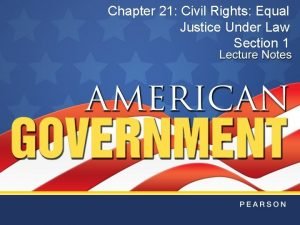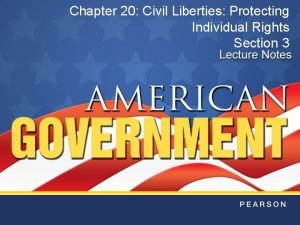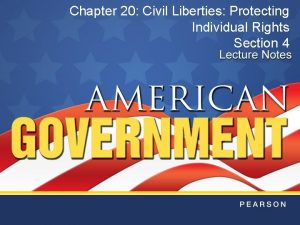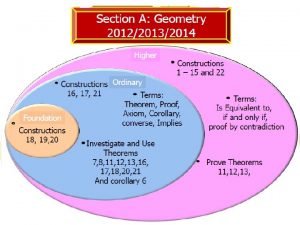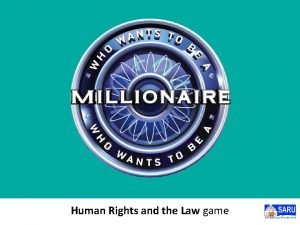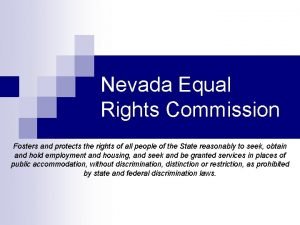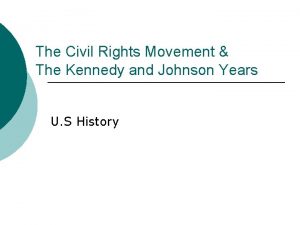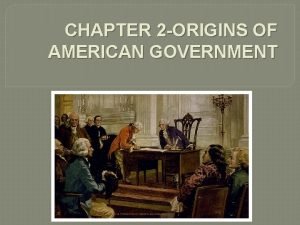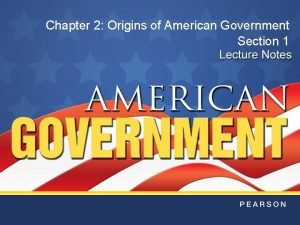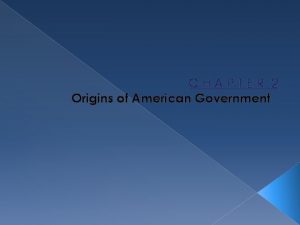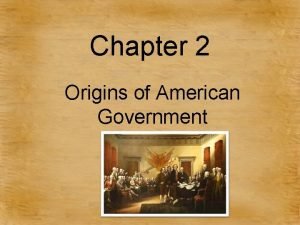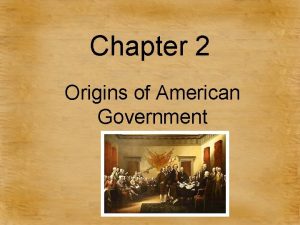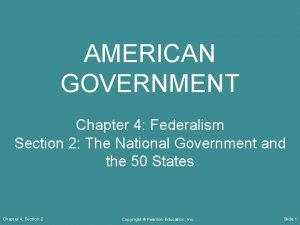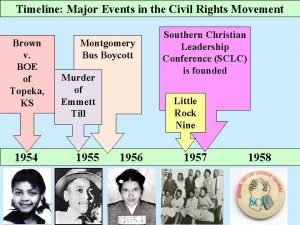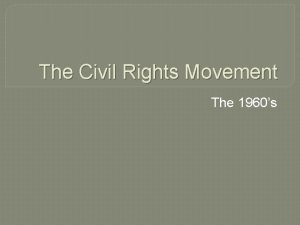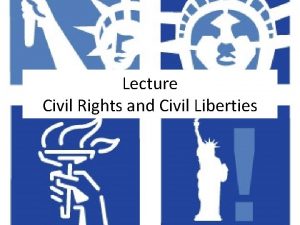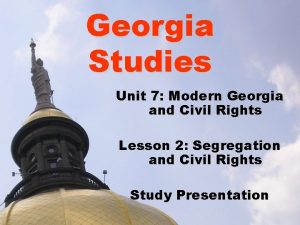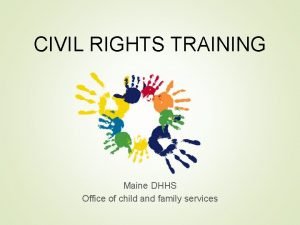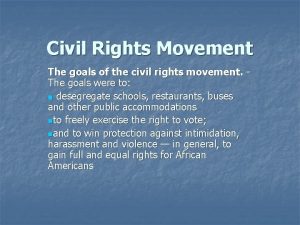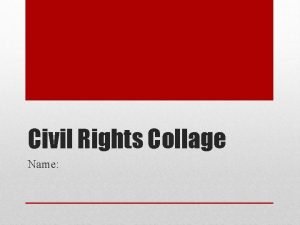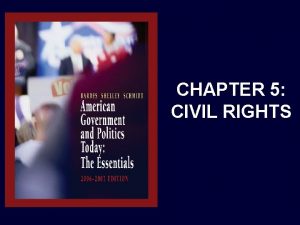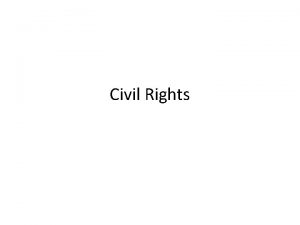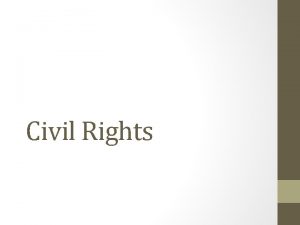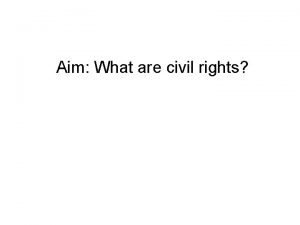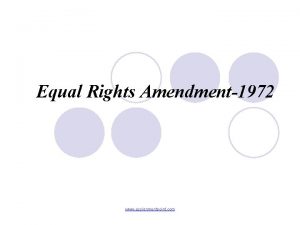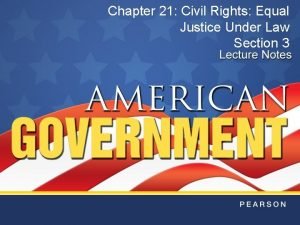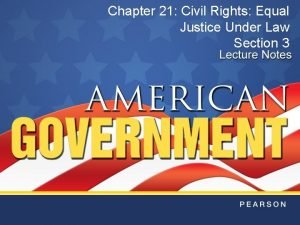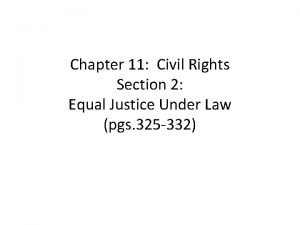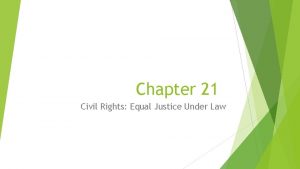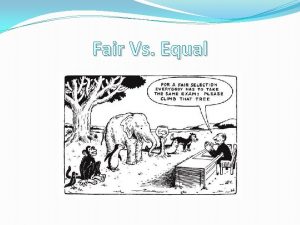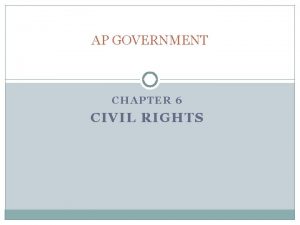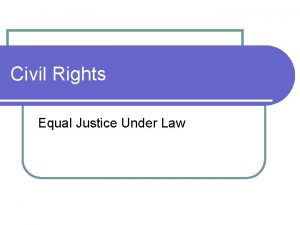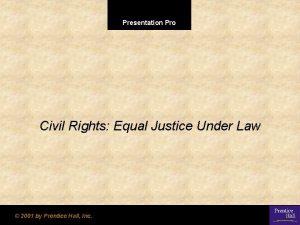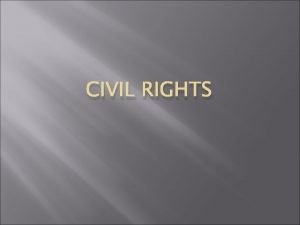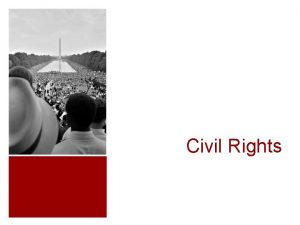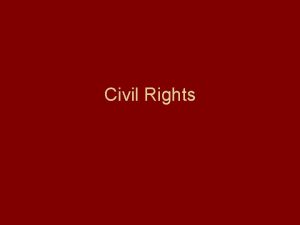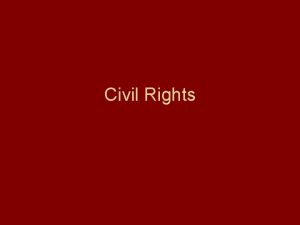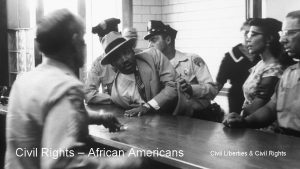American Government Chapter 21 Civil Rights Equal Justice

































- Slides: 33

American Government Chapter 21 Civil Rights: Equal Justice Under Law

Section 1 ► Diversity and Discrimination in the American Society

A Heterogeneous Society Heterogeneous ► § To Greek words hetero and genos different – race, family, or kind ► AKA… composed of a mix of ingredients ► § § U. S. has consistently been predominantly white However, U. S. has become increasingly more heterogeneous over the last few decades due to an influx of immigrants ► aliens legally admitted as permanent residents

Race-Based Discrimination African Americans ► § § § 2 nd largest minority group in U. S. Been victims of consistent and deliberate, unjust treatment Most Constitution guarantees of equality for all people came from and for African Americans

Race-Based Discrimination (Con’t) Native Americans ► § § Many killed by European diseases and wars Forced to live on or near reservations ► currently life expectancy 10 years less than national average

Race-Based Discrimination (Con’t) Hispanic Americans ► § § § Spanish-speaking background Largest minority group in U. S. Basic Groups ► ► Mexican Americans Puerto Ricans Cuban Americans Central and South Americans § § Many are refugees One who seeks protection from war, prosecution, or danger

Race-Based Discrimination (Con’t) Asian Americans ► § Forced to assimilate ► § process by which people of one culture merge into and become part of another culture Many came in 1800’s to work in mines and build railroads in the West

Discrimination Against Women are not minority in U. S. ► § Law and public policy have generally not given women equal rights Eventually gain suffrage ► § Only 1% of the nations top public offices have been held by women since 1789

Discrimination Against Women (Con’t) Fewer than 20% of doctors, lawyers, and college professors are women ► § ► Women earn on average less than men Some claim there is a glass ceiling

Section 2 ► Equality Before the Law

Equal Protection Clause Everyone is different and democratic ideals demand government treat all people alike ► § “No state shall… deny to any person within it jurisdiction the equal protection of the laws” 14 th Amendment Reasonable Classification ► § There must be some discrimination (Classification) ► § However it cannot be unreasonable Most acts by government have been found constitutional by Supreme Court

Equal Protection Clause (Con’t) The Rational Basis Test ► § It asks: Does the classification in question bear a reasonable relationship to the achievement of some proper governmental purpose? ► Must have a “Public Good” goal

Equal Protection Clause (Con’t) Strict Scrutiny Test ► § Higher Standard if: Involves “fundamental rights” such as votes, travel inter-state, and 1 st Amendment ► “Suspect Classifications” as race, sec, or national origin ► § Much harder for states to discriminate

Segregation in America The separation of one group from another ► § Jim Crow Laws laws that separate people based on race ► In both public and private facilities ► Separate-but-equal doctrine ► § Plessy V. Ferguson ► Held that the Equal Protection Clause supported separate facilities as long as the separate facilities were equal

Segregation in America (Con’t) Brown v. Board of Education ► § § Court held that segregation by race in public education is unconstitutional Some states tried to block integration ► § The process of bringing a group into the mainstream of society Civil Rights Act of 1964 ► Allowed Justice Department to file suits against desegregation acts

De Jure, De Facto Segregation by law or legal sanction ► § Now abolished De Facto Segregation ► § § Segregation, not based on law, but normally housing patterns Busing and redrawing district lines have worked to avoid de facto segregation Segregation in other fields ► § In public arenas segregation is illegal as well

Classification by Sex 14 th Amendment, according to the Supreme Court, also gives Equal Protection to women ► § However, women are not drafted

Section 3 ► Federal Civil Rights Laws

Civil Rights: Reconstruction to Today 1870’s to late 1950’s, Congress did not pass a meaningful civil rights legislation ► § Changed by pressures in 1957 ► From Civil Rights movement by people like Martin L. King Jr.

Civil Rights: Reconstruction to Today (Con’t) The Civil Rights Act of 1964 ► § § Passed after an 83 day debate Outlaws discrimination in a number of areas No person may be denied access or refused service in various “public accommodations” ► No Discrimination if the program receives public funding, otherwise federal funds will be cut ► Employers and Unions cannot discriminate ► § Against race, color, religion, national origin, sex, or physical disability

Civil Rights: Reconstruction to Today (Con’t) Civil Rights Act of 1968 ► § § Called open housing act Can not sell or rent on the grounds as laid out in Civil Rights Act of 1964

Affirmative Action Policy requires that most employers take positive steps to remedy the effects of past discriminations ► § Private businesses must try to make their work force reflect the makeup of the local population Reverse Discrimination ► § § Critics say affirmative action is unconstitutional Discriminate against the majority group

Affirmative Action (Con’t) The Bakke Case ► § Regents of University of California v. Bakke in 1978 ► ► 16 out of 100 spots reserved for non-whites and Supreme Court found the quotas to be unconstitutional Though race could be a factor among many other factors Later Cases ► § § Quotas can be used in extreme situations Recent court cases have made it harder to prove discrimination

Affirmative Action (Con’t) The Adarand Case ► § § Adarand Constructors v. Pena, 1995 Found any preferential treatment based on race unconstitutional ► “Whenever the government treats any person unequally because of his or her race, that person has suffered an injury. ” § Justice Sandra Day O’ Connor

Affirmative Action (Con’t) Affirmative Action on the Ballot ► § California voters voted to get rid of most affirmative action programs ► circuit court agreed and Supreme Court refused to see case

Section 4 ► American Citizenship

Question of Citizenship ► 14 th Amendment declares that a person can become an American citizen either by birth or by naturalization

Citizenship By Birth Citizenship by birth is determined by either Jus Soli or Jus Sanguinis ► § § Jus Soli is anyone born on U. S. soil, or U. S. territory Jus Sanguinis is anyone who becomes citizen based on law ► Parents are U. S. citizens

Citizenship By Naturalization The legal process by which a person becomes a citizen of another country at sometime after birth Individual Naturalization ► ► § An alien becomes a citizen individually ► a citizen or national of a foreign state living in this country Collective Naturalization ► § Naturalization en masse ► When an entire group has been naturalized

Loss of Citizenship Everyone has the voluntarily ability to get rid of his or her citizenship Expatriation ► ► § Denaturalization ► § ► The legal process by which a loss of citizenship occurs When a naturalized citizen loses their citizenship through a court order, because they became a citizen by fraud or deception Marriage does not help one gain or lose citizenship

A Nation of Immigrants Regulation of Immigration ► § § Courts have ruled the power to control the nation’s border is an inherent power of the United States U. S. had mostly open borders from independence to 1890’s ► New restrictions continually since

A Nation of Immigrants (Con’t) Present Immigration Policies ► § Immigration Act of 1990 governs the admittance of aliens to U. S. ► 675, 000 allowed each year Deportation ► § A legal process in which aliens are legally required to leave the U. S. ► Illegally achieved evidence could be used because it is a civil law

Undocumented Aliens A Troublesome Situation ► § Nearly 10 -12 Million illegal aliens reside in the U. S. Current Law ► § § A crime to hire illegal aliens Undocumented aliens given one year of amnesty to become a citizen
 Chapter 21 civil rights equal justice under law
Chapter 21 civil rights equal justice under law Civil rights webquest
Civil rights webquest Chapter 20 civil liberties protecting individual rights
Chapter 20 civil liberties protecting individual rights Chapter 14 postwar prosperity and civil rights
Chapter 14 postwar prosperity and civil rights Levittown apush
Levittown apush Chapter 20 civil liberties protecting individual rights
Chapter 20 civil liberties protecting individual rights Chapter 20 civil liberties protecting individual rights
Chapter 20 civil liberties protecting individual rights Equal height equal light
Equal height equal light Equal height equal light
Equal height equal light Equal sharing and equal grouping
Equal sharing and equal grouping Side opp equal angle
Side opp equal angle Meridionalnet
Meridionalnet Example of human rights
Example of human rights Kara jenkins nevada
Kara jenkins nevada Why did the struggle for equal rights intensify
Why did the struggle for equal rights intensify Chapter 2 american government
Chapter 2 american government Chapter 2 origins of american government vocabulary
Chapter 2 origins of american government vocabulary Chapter 2 origins of american government answer key
Chapter 2 origins of american government answer key Chapter 2 origins of american government worksheet answers
Chapter 2 origins of american government worksheet answers Origins of american government chapter 2
Origins of american government chapter 2 Chapter 2 origins of american government
Chapter 2 origins of american government American government chapter 4
American government chapter 4 Civil rights timeline of events
Civil rights timeline of events Civil rights sitins
Civil rights sitins Rosa parks mother
Rosa parks mother Right to die
Right to die Civil rights movement jeopardy
Civil rights movement jeopardy Unit 7 modern ga and civil rights
Unit 7 modern ga and civil rights Usda civil rights training
Usda civil rights training Civil rights training child nutrition programs
Civil rights training child nutrition programs Goals of the civil rights movement
Goals of the civil rights movement Civil rights in child nutrition programs
Civil rights in child nutrition programs Civil rights graphic organizer
Civil rights graphic organizer Civil rights leaders collage
Civil rights leaders collage
